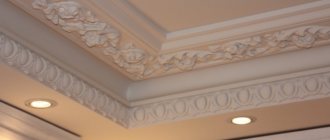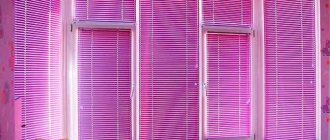How much water can a suspended ceiling withstand?
According to major manufacturers of suspended ceilings, the canvas can withstand up to 100 liters of water per 1 square meter. m. The following conditions are taken into account:
- A small area of a stretch ceiling is stronger and can support a larger volume than a wide canvas.
- If the ceiling is stretched very tightly, then its elastic properties and density become less. This means that such a fabric will tear faster and will not withstand heavy loads.
- The material from which the ceiling is made plays an important role.
The stretch fabric made of polyvinyl chloride film stretches and does not allow moisture to pass through, forming a bubble with water, and fabric ceilings remain almost flat, but leak slightly.
Interior finishing experts say that the actual amount of water that suspended ceilings can withstand is from 60 to 90 liters.
Options for draining water from the ceiling
One option to remove water from the ceiling is to drain it through the opening of a chandelier or lamp. This can only be done after the room has been de-energized. The step-by-step process will look like this:
- Dismantle the electrical appliance closest to the water bottle.
- A hose is inserted into the hole to drain water and drain into a container of the required volume.
- To change the container, the hose is temporarily pinched, stopping the flow of water.
This draining method is the most convenient, since it does not require preparing a hole for draining or dismantling the coating.
Removing the liquid with partial dismantling is necessary when a ceiling installed by the harpoon method is flooded. In this case, a small hole is cut in the area close to the water bubble and the water is drained over the edge of the PVC film.
What to do if the suspended ceiling is flooded
If the owner of the apartment discovers that the neighbors above have flooded the suspended ceiling, he must take urgent measures. They operate in order:
- Disconnect the apartment. You need to go out into the entrance and turn off the machine. If this is not done, a short circuit may occur in the wiring. While there is electricity in the house, touching the suspended ceiling and draining water from it is strictly prohibited.
- Fix the water leak yourself. Urgently inform your neighbors that they are flooding their apartments from below. If they are missing, then you should go down to the basement and turn off the common valve. A leak that has formed in a one-story house should be found and the hole in the roof should be sealed by climbing into the attic.
- Remove electrically powered devices (TV, computer), as well as carpets and bedspreads from the room.
- Large furniture must be completely covered with film.
- Prepare a container for collecting water.
- Drain the water from the suspended ceiling.
- Dry the canvas and restore.
Comment! If the leak cannot be eliminated on your own, you need to contact special services by calling the hotline.
Method 2: solid ceiling
If there are no technical holes in the ceiling, choose an inconspicuous part of the ceiling for drainage, for example, a corner near the door.
- Remove the decorative baseboard attached to the edge of the ceiling.
- Using a blunt object, release the edge of the ceiling panel from the fastening so as not to damage it. Bend the fabric and insert a rubber hose into the gap. If there is no hose, simply pull the blade below the level of the bottom point of the bubble. You should not pull the material too hard, it is quite elastic, do everything slowly and carefully.
- Carefully drain the water into a nearby container.
- Allow the ceiling to dry and restore its original shape. After this, put the ceiling plinth in place.
How to drain water from a suspended ceiling without a technical hole
How to pour water out of a stretch ceiling
To pump out water, it is better to contact a company that installs canvases, but if for some reason you cannot wait for help, then you can drain the water yourself. The main thing is to do it according to the rules. Methods for draining water differ depending on the location of the volume of liquid. The ceiling may sag due to water in the areas where round lamps or chandeliers are located. Sometimes water spreads evenly over the entire surface of the ceiling. Below are methods that will help you solve this problem yourself.
How to drain water from a suspended ceiling using a special valve
Some manufacturers, when installing the canvas, embed a special valve that will help apartment owners in case of flooding to pump out the water themselves using a hose. Unscrew the valve cover and place a bucket under it. When the water has drained, you can start drying and screw on the lid.
However, homeowners note that the valve is not always effective. Often the flood is localized on the opposite side. The stretch ceiling sags, and it is impossible to drain the water through a special hole; you have to look for alternative ways to fix the problem yourself.
How to pour water from a suspended ceiling through the hole for lamps
It is easier to remove water yourself using the holes for the lamp and a hose. Step-by-step instruction:
- Remove the chandelier or lamp from the mounting ring. You need to choose a lamp that is located a little further than the water bubble so that water does not pour out during dismantling.
- Carefully insert the hose into the resulting hole and push it into the place where the water accumulates. The return end of the hose is lowered into a container to collect water.
- In order for water to flow down the hose, you need to lean its end against your mouth and strongly inhale air from the tube and quickly lower the hose into the bucket. If this method does not help, then you should call a friend for help. His task is to support the water bubble with his hands, slightly pushing it up. Then the water will begin to drain.
When one bucket is full, bend the edge of the hose and lower it into another container. The assistant must empty the buckets independently as quickly as possible. After the water pressure weakens, you should push the canvas upward again to expel the water. At the end, the suspended ceiling needs to be dried, and then a chandelier or lamp must be screwed in.
How to pump water out of a suspended ceiling if there are no holes
In this case, you will not be able to drain the water yourself. You will need the help of at least one person:
- Not far from the location of the flood, you should separate the edge of the tension fabric from the fastening to the wall.
- Place a stepladder under the work area. The harpoon of the canvas is independently cordoned off from the profile, having first removed the decorative tape. Dismantling is carried out using a special semicircular spatula.
- An assistant should stand on a stepladder and hold the blade firmly with both hands, pulling slightly. This is necessary to prevent water from flowing down the wall. A long rubber hose is inserted into the hole, then brought to the place where the water accumulates. To expel the water, you need to inhale air from a hose yourself or lift the lowered stretch ceiling.
The further procedure is the same as in the previous method of pumping out water.
You can watch how to drain water from a suspended ceiling in this video:
What to do with a suspended ceiling after flooding
After the flood is eliminated, the canvas is greatly stretched and becomes wrinkled. To restore a smooth surface, heat treatment will be required. Manufacturers recommend seeking the help of professionals, but you can do this work yourself.
How to dry a suspended ceiling yourself after flooding
To dry the ceiling after a flood yourself, you will need a hair dryer or a heat gun. Turn on the hair dryer at full power and move it away from the coating by 30-40 cm.
Comment! You cannot keep the hair dryer in one place for a long time. The surface should be heated evenly, directing the air flow in different directions.
The procedure will take a long time from 1 to 3 hours. After drying, the suspended ceiling will regain its original attractiveness without compromising the design. Only after final drying can lighting fixtures be installed and electricity connected.
Photos of ceilings after flooding can be seen below:
There was a small bottle of water at this place
Here the scale of the flood is larger, a small amount of water still remains inside
The damaged canvas must be completely replaced; the gap was caused by inaccurate removal of the lamp
How to restore a suspended ceiling after flooding
Yellow stains often form on fabrics after flooding. You can remove them yourself using special or home remedies.
- Method No. 1. Drip ammonia onto a soft fleecy cloth and treat the affected area. If you mix ammonia with a soap solution, the cleaning effect is enhanced. The applied solution should be left on the ceiling surface for 10 minutes and then wiped with a clean damp cloth.
- Method No. 2. Dishwashing liquid should be diluted in warm water in a ratio of 1:3.
Wipe the area where the stain appears with the solution. Do not use hot water, and you should also pay attention to the composition of the product. Important! So that it does not contain abrasive substances. - Method No. 3. A car interior cleaner can be applied to a sponge and gently treat the stain. Further actions depend on the instructions on the bottle. Some products need to be washed off, while others do not.
- Method No. 4. Hydrogen peroxide 9% can only help with the formation of pale and small spots. You need to apply the product to the canvas using a clean rag soaked in the solution.
Comment! Do not use products containing acetone. The PVC film may dissolve, and the fabric will turn yellow even more.
These methods can only be used as an alternative to special means for removing stains from ceilings yourself. Hardware stores sell special detergents for different types of coating.
Features of drying ceilings after draining water
Experts do not recommend rushing to close the canvas in baguettes - you need to dry not only the tension material itself, but also the space behind the ceiling. If the neighbors flooded the suspended ceiling, but the owners did not dry it completely, after a short time mold will form on the base surface.
For drying, use a hair dryer or a heat gun; you need to dry it very carefully so that the film does not dry out. The drying period depends on the degree of flooding; on average, the procedure takes from 3-5 hours. But it sometimes takes up to 2-4 days to dry ceilings with a thick layer of plaster that are heavily saturated with water.
Important! In the process of retaining moisture, the PVC film is stretched. To restore their original appearance, you should warm up the stretch marks until they are completely eliminated.
Tips and tricks
When draining water from a suspended ceiling yourself, it is important to follow several recommendations:
- When preparing tools for draining, it is advisable to purchase hose plugs. Constantly squeezing its edge will be inconvenient, and a small amount of water may leak.
- Most often, the water bubble on the ceiling appears smaller than the actual volume of water. Therefore, it is impossible to assess the scale of the flood by eye. You need to prepare as many containers as possible to collect water.
- If your neighbors flooded the ceiling with hot water, then you need to start draining it as soon as possible. Increased water temperature with prolonged exposure to the canvas deforms it so much that subsequently restoration of the coating will be impossible.
- The maximum number of days for which water drainage can be delayed is 3 days. It is advisable to start fixing the problem immediately, but if the apartment owner does not dare to drain the water himself, and the flood happened over the weekend, then you can wait. During these days, it is recommended to turn off the power in the flooded room.
- An urgent solution to the problem requires a ceiling that is sagging in the place where the chandelier is attached with sharp corners or decorative elements. With strong tension, the coating becomes thin and less durable. If the bubble comes into contact with a sharp corner, it may burst. Ceilings with seams are also dangerous.
- If the canvas is damaged, the small hole can be temporarily closed with a sticker or masking tape. The ceiling needs to be replaced to avoid damage to property in the event of another flood.
- To pump water out of a hose, inhaling air from the tube with your mouth is only possible in extreme cases. For this purpose it is better to use a medical bulb. If you inhale sharply, dirty water can enter the mouth or lungs.
- When installing ceilings in places where plumbing runs in the upper apartment, it is better to install film ceilings. They retain water better and recover more easily.
- Do not smooth out a small water bubble. In this case, the water spreads over the entire area of the covering and can flow in the places where the canvas is attached to the walls. To avoid this problem, when installing the ceiling you need to use a special sealant that will reliably close the gaps between the profile and the wall.
- To prevent a flood in your own apartment during the renovation stage, you need to lay the floor correctly. Professionals recommend laying bitumen and roofing felt screeds. This is a reliable way to retain water within your apartment and protect your neighbors’ ceilings from a similar problem.
- It is very difficult to carry out flood elimination work on your own alone. The help of 1-2 people is required, otherwise everything can end in disaster.
- If the scale of the flood was very large, or the water stood inside the stretch ceiling for more than 3 days, complete dismantling of the canvas and drying of the main ceiling will be required. The plaster must be treated with special agents to prevent the formation of mold.
- For drying you need to use only a heat gun or a hair dryer. In unreliable sources you can find advice on restoring the coating using a regular hair dryer. This method doesn't work. To restore the canvas you need at least 200 °C.











